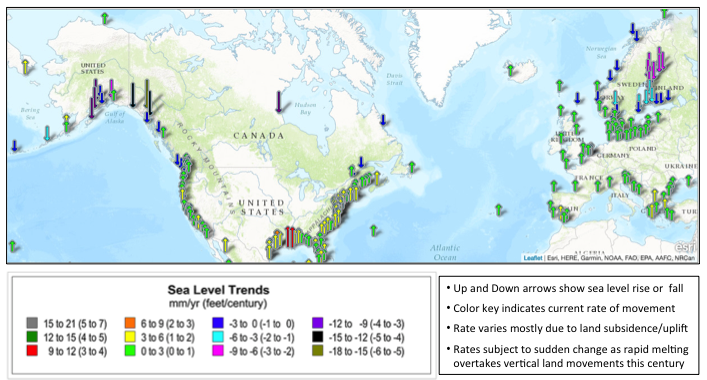Don’t Be Fooled by Falling Sea Level
Rising sea level is in the news more and more as coastal communities experience frequent flooding and the perils from the accelerated melting in Antarctica and Greenland becomes more ominous. Surprisingly there are some areas across Alaska, Canada and Scandinavia that currently have sea levels falling which may cause them not to prepare for rising sea level. That would be a serious mistake as the falling will turn into sea level rising in the not too distant future. With that change in direction, many of these areas will be caught “off guard” and likely be even less prepared than the places already feeling the effects of sea level rise. It’s worth understanding the confusing phenomenon of why sea level is falling in some places.
As readers of this blog are likely familiar, globally overall sea level is rising for two reasons: 1) Glaciers and ice sheets melt causing water or icebergs to enter the ocean, directly raising sea level. 2) As the planet continues to warm, over 90% of the excess heat is stored in the ocean, already warming the sea by about one and a half degrees Fahrenheit (one degree Celsius) over the last century. That warming causes “thermal expansion” the characteristic that most substances expand very slightly with warmer temperature. For scale, the warming over the last hundred years has caused roughly three or four inches (8 -10 cm) of higher sea level just from the thermal expansion.
What most people don’t realize is the amount of sea level rise varies greatly by location, due mostly from land subsidence (going down), or land uplift (going up). For example, sea level rise in Virginia Beach measures about thirty inches over the last century. That is the sum of the three to four inches from thermal expansion, about an equal amount from ice melting, PLUS approximately twenty two inches from land subsidence — in that location mostly due to plate tectonics. New Orleans, Venice and Jakarta are good examples of above average rising sea level also due to land subsidence, causing serious problems with routine flooding already.
As a general rule, the areas of falling sea level are in the high latitudes, Alaska, Canada, and Scandinavia: Denmark / Greenland, Norway, Finland and Sweden. To a lesser extent parts of northern Russia. In those areas sea level appears to be falling, because the land is rising faster than the ocean is. That land “uplift” is mostly due to the earth’s crust slowly rebounding from the melting of the glaciers and ice sheets as the last “ice age” ended over the last ten to twenty thousand years. Those ice sheets were miles thick and incredibly heavy. That weight pushed the Earth’s crust downward — perhaps several feet (a meter). The land is still recovering or rising ten thousand years later. The rate of rise is on the order of half an inch (roughly a centimeter) annually.
The problem is that average global sea level rise is now about a quarter of an inch a year (4 mm) just slightly less than those rates of land uplift. Thus it appears that sea level is falling. That will soon change however, because sea level rise is accelerating quickly, and will inevitably overtake the slow rate of land uplift. Significant sea level rise is now unavoidable as described in my post last year, “The Elephants of Antarctica and Greenland”.
In locations from Shishmaref, Alaska to Prince Edward Island, Canada it seems as if they are experiencing sea level rise, but in reality they are experiencing dramatic shoreline erosion, caused by the melting of massive ice on the shoreline and thawing of the permafrost as the warming accelerates. Winter waves can now get directly at the shore, due to the lack of protective ice. The thawed permafrost means the beaches and shore are much softer than in recent centuries, and thus subject to erosion. This looks like erosion from sea level rise but it’s really not, as sea level has actually fallen in these areas. However, as sea level rise accelerates – which it will – it will surprise many areas in the north, who have not really experienced it yet making the erosion even worse. That turnaround or “whiplash” could make it even harder to adapt.
Planning ahead would be wise. The combination of the melting sea ice, erosion, and net rising sea level will be a challenge for all coastal communities. The time to plan for adaption is now.

